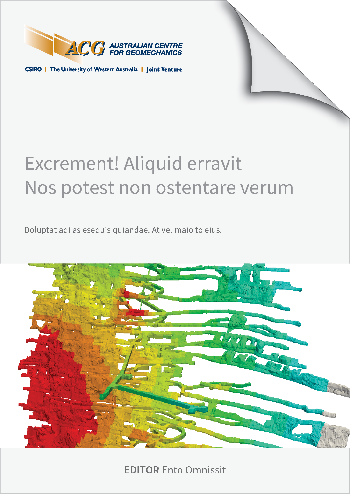Advancements in hydromechanical simulation

|
Authors: Chung, T; Dehkhoda, S; Flatten, A; Levkovitch, V |
DOI https://doi.org/10.36487/ACG_repo/2435_G-03
Cite As:
Chung, T, Dehkhoda, S, Flatten, A & Levkovitch, V 2024, 'Advancements in hydromechanical simulation', in Daniel Johansson & Håkan Schunnesson (eds), MassMin 2024: Proceedings of the International Conference & Exhibition on Mass Mining, Luleå University of Technology, Luleå, pp. 907-916, https://doi.org/10.36487/ACG_repo/2435_G-03
Abstract:
The significance of hydrogeological simulations in mine-scale modelling cannot be overstated. Accurate hydrogeological models are pivotal for ensuring mine safety, predicting environmental impacts, and planning for potential mine closures. These simulations provide insights into groundwater behaviours and fluid-rock interactions, which are critical for informed decision-making in mining operations. Recognizing the limitations of traditional hydro simulations, which often rely on assumptions like steady-state and fully saturated flow, we have pioneered a cutting-edge hydro framework. This approach offers a more realistic representation of subsurface water dynamics. The traditional methodologies, although foundational, can sometimes oversimplify complex hydrogeological phenomena, potentially leading to inaccurate predictions. Our innovative framework, built on the open-source parallel finite element framework MOOSE, encapsulates real physics, emphasizing unsaturated flow dynamics and accounting for geological inconsistencies such as faults. It is equipped with realistic boundary conditions, including drainage, rainfall, and the nuanced interaction between flexible flux and pore water pressure. By adopting an element-based approach to material properties, the model ensures that parameters like permeability, porosity, and saturation parameters are not generalised but tied to specific geological domains up to elements. Furthermore, the fully transient nature of our simulation allows for time-dependent observations, providing an evolving perspective of the mine's hydrogeological landscape. Notably, the framework's ability to simulate pit reflooding sets it apart, addressing a crucial aspect of mine safety and environmental conservation. These unique features of our novel framework not only elevate the accuracy and depth of mine scale hydromechanical simulations but also underscore the need for continuous innovation in the realm of hydrogeological modelling.
References:
Anderson, M. P. & Woessner, W. W. (1992). Applied groundwater modeling: Simulation of flow and advective transport. Academic Press.
Bear, J. & Verruijt, A. (1987). Modeling groundwater flow and pollution.
Corey, A. T. (1954). The interrelation between gas and oil relative permeabilities. Producers Monthly.
Flatten, A. & Beck, D. A. (2015). Applications of hydro-mechanically coupled 3D mine and reservoir scale, discontinuous, strain-softening dilatant models with damage. American Rock Mechanics Association, ARMA. 49th US Rock Mechanics and Geomechanics Symposium, San Francisco, USA.
Flatten, A., Reusch, F. & Beck, D. A. (2016). The application of hydro-mechanical mine-scale modelling for large block caving operations. 7th International Conference & Exhibition on Mass Mining – MassMin 2016, Sydney, Australia.
Genuchten, M. Th. van (1980). A closed-form equation for predicting the hydraulic conductivity of unsaturated soils. Soil Science Society of America Journal, 44(5), 892-898.
Lindsay, A. D., Slaughter, A. E., Permann, C. J., Peterson, J. W., Miller, J. M., Andrš, D., Gaston, D. R., Kong, F., Martineau, R. C. & Tonks, M. R. (2022). 2.0 - MOOSE: Enabling massively parallel multiphysics simulation. SoftwareX, 20, 101202. .
Mahyari, A. T. & Selvadurai, A. P. S. (1998). Enhanced consolidation in brittle geomaterials susceptible to damage. Mechanics of Cohesive-frictional Materials. Wiley.
Nguyen, T. S. & Selvadurai, A. P. S. (1998). A model for coupled mechanical and hydraulic behaviour of a rock joint. International Journal for Numerical and Analytical Methods in Geomechanics, 22(1), 29-41. <29::AID-NAG907>3.0.CO;2-N
Rutqvist, J., Birkholzer, J. T., Cappa, F. & Tsang, C.-F. (2009). Modeling of damage, permeability changes and pressure responses during excavation of the TSX tunnel in granitic rock at URL, Canada. Environmental Geology, 57, 1263-1274.
Selvadurai, A. P. S. & Shirazi, A. (2005). An elliptical disc anchor in a damage-susceptible poroelastic medium. International Journal for Numerical Methods in Engineering, 62(8), 1063-1088.
Shirazi, A. & Selvadurai, A. P. S. (2005). Lateral loading of a rigid rock socket embedded in a damage-susceptible poroelastic solid. International Journal of Geomechanics.
Terzaghi, K. (1936). The shear resistance of saturated soils and the angle between the planes of shear. Proceedings of the 1st International Conference on Soil Mechanics and Foundation Engineering, 1, 54-56.
Wilkins, A., Green, C. P. & Ennis-King, J. (2020). PorousFlow: A multiphysics simulation code for coupled problems in porous media. Journal of Open Source Software, 5(55), 2176. .
Wilkins, A., Green, C. P. & Ennis-King, J. (2021). An open-source multiphysics simulation code for coupled problems in porous media. Computers & Geosciences, 154,104820. .
Wolkersdorfer, C. (2008). Water management at abandoned flooded underground mines: Fundamentals, tracer tests, modelling, water treatment. Springer.
Younger, P. L. (2004). Environmental impacts of coal mining and associated wastes: A geochemical perspective. Geological Society, London, Special Publications, 236(1), 169-209.
© Copyright 2025, Australian Centre for Geomechanics (ACG), The University of Western Australia. All rights reserved.
View copyright/legal information
Please direct any queries or error reports to repository-acg@uwa.edu.au
View copyright/legal information
Please direct any queries or error reports to repository-acg@uwa.edu.au